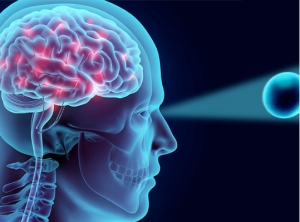How else can we train the brain?

The human brain has often been likened to a computer, in that it will receive input, process that input, and yield an output. That is a simplistic analogy to start with, but if we add in the brain’s ability to “learn” from every interaction and intervention then we get a better sense of what our brain is truly capable of. We have computers that also “learn” as they go along and we label that as “Artificial Intelligence” – the computer trying to do what the brain already does.
We can externally observe and map brain activity, and we can also theorize about brain synapses being electrically fired, allowing us to think, to process, to feel, to do all those things the brain is in control of. Most of our muscles can be directly controlled by our brain; we just think about lifting our legs to climb stairs and our leg muscles obey. Other muscles can be indirectly controlled by the brain, even though they will continue to function without any thinking required, such as our heart and diaphragm. We can decide to breathe deeper or hold our breath for a time, and fear can cause our heart rate to increase, but these are indirect and/or temporary brain interventions.
Training our brain is happening all through our life, as we learn to cope with the world we live in. We learn from those around us; parents, siblings, friends, co-workers, and all of that learning is accomplished using all of our senses. Our five senses provide input to the brain, and we process our inputs, learning how to survive, improve, and generally progress. There is one sense that is dominant in our physical activities and reactions – vision – which contributes 80-90% of total input. Neuroscience research is positing that by improving vision input to the brain, the brain can respond in beneficial ways. We all know that success in some aspects of our lives can come down to a matter of millimeters and/or micro-seconds, especially in sports at the elite level.
There are several aspects to vision, and what we know most about is acuity, the ability to see things clearly, and we also know that acuity can be improved with aids like contact lenses and glasses. But beyond acuity is what our brains can do with vision inputs, things like hand-eye coordination, visual tracking and spatial awareness for good decision making. Neuroscientists can work with behavioral optometrists to train for improved athletic performance by providing specific exercises for the eyes. The job of the eyes is to transmit visual data to the brain, allowing the brain to process the data quickly and then tell the eye where to look next. Specific eye exercises can be designed to calibrate the eyes to move around as fast as possible to the next target, consistent with the brain’s understanding of the visual data just received and integrated with all other sensory inputs, like sound and touch. The brain can process images that the eye sees for as little as 13 milliseconds, so training the brain with vision improvement exercises has great potential for improving overall athletic performance, when millimeters and milliseconds can mean the Gold Medal, instead of Silver or Bronze.
There are at least 10 vision skills used in daily activities, and below are seven of the most important for transmitting accurate and useful vision data to the brain, where that data needs to be processed quickly and precisely.
The brain can be trained to respond in the most beneficial way for every situation, given that the received visual data is of a very high quality. Achieving that high quality is what specific eye exercises are designed to promote.
The seven most important visual skills needed to achieve high athletic performance:
- Eye Movement: first step is to have both eyes move in synch
- Colour Perception: to determine friend or foe, or slow down / speed up
- Alignment: both eyes working together for accurate target tracking
- Depth Perception: precise location of targets in 3D space
- Peripheral Vision and Awareness: seeing targets at the outer edges of your visual range
- Focus: sustained in-focus binocular vision for moving targets
- Visual Perception: being highly aware of everything in your visual field
The bottom line is that human athletic performance can be enhanced and optimized by developing and training the eye to be a high performance organ. Coupled with personalized, appropriate brain response training, individuals can see their eyes as not only a window to the soul, but a window to the brain and a higher success rate.
Trend Disruptors is monitoring these scientific developments and technologies, and will identify relevant investment opportunities to lead the well informed investor to success.
Stay tuned …

